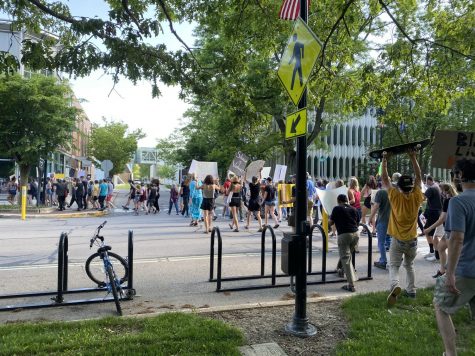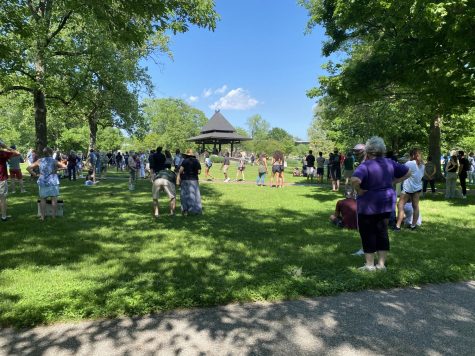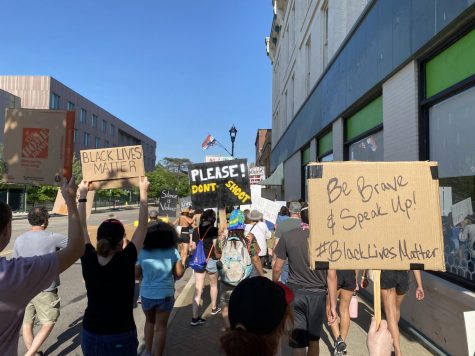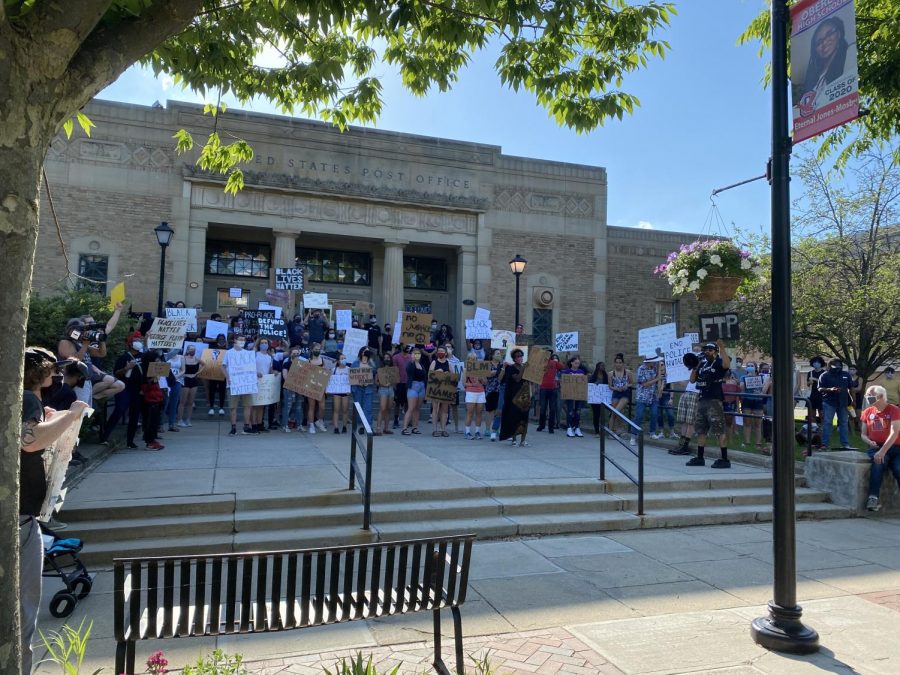Black Lives Matter Protesters Gather in Tappan Square
Black Lives Matter protesters marched from Tappan Square to the Post Office on June 6.
Protesters gathered in Tappan Square on June 6 to protest the murders of George Floyd and other Black men and women killed by police. During the demonstration, several speakers addressed the crowd to talk about the history of police violence against communities of color and demanded change on the local and national level.
After protests against police brutality spread in cities in the U.S. and across the world, Oberlin resident Janet Gonzalez formed a Facebook group called Oberlin Peaceful Demonstration. Several other community members, including Jack McMillin, OC ’20, Jennifer Caicedo, OC ’19, and Daniel Spearman, OC ’16, also participated in the organization of the protest. Co-organizer Johnny Spinkston Jr., OC ’16, led a march from Tappan to the U.S. Post Office.
“We wanted to use the momentum of everything that was happening and get as much visibility for the cause of Black lives and defunding the police in Oberlin, and also to mobilize community members and give them tools to take direct action and protest here in Ohio,” McMillin said. “Ultimately it was to mobilize, gain visibility, and amplify Black voices in the community as much as possible.”
 Several community members made speeches about the history of policing, anti-Black violence, and Black activism in America that led to the historic levels of protests seen in the last few weeks.
Several community members made speeches about the history of policing, anti-Black violence, and Black activism in America that led to the historic levels of protests seen in the last few weeks.
“Maybe you’re here for one of the countless others, Black, Latinx, Native American, White, Male, Female, LGBTQ, that have fallen, or been accosted by agents of the state acting with the impunity that comes with a badge and the hatred that comes from this county’s never-ending love affair with white supremacy,” Spearman said to protesters. “Perhaps you’re curious, maybe you want to help, maybe you came just to see what all the fuss was about. No matter your reason, you are here, and hopefully by the end of today you will have some idea of where to go next.”
Other speakers echoed this thought, like Jane and Eric Nord Associate Professor of Africana Studies Pamela Brooks, who highlighted the history of Black female activists who spoke out against police violence like Ida B. Wells-Barnett, Sojourner Truth, Harriet Tubman, and Ella Jo Baker. Her speech also touched on the way the modern prison system is used to oppress people of color.
“It is important for all of us to rethink the meaning of defunding policing and creating resources for Black communities,  and we have to ask ourselves why is it that so many of our own African American young men and our Latinx young men are found in prisons like that state prison right up the street from us at Grafton,” Brooks said about her speech at the demonstration. “There are so many young Black men from Lorain County and from surrounding areas, Cuyahoga County, that end up in Grafton — almost as if it serves as a rite of passage.”
and we have to ask ourselves why is it that so many of our own African American young men and our Latinx young men are found in prisons like that state prison right up the street from us at Grafton,” Brooks said about her speech at the demonstration. “There are so many young Black men from Lorain County and from surrounding areas, Cuyahoga County, that end up in Grafton — almost as if it serves as a rite of passage.”
Nationwide protests throughout the last few weeks have focused not only on police brutality, but also on systemic racism throughout the criminal justice system. In the U.S. and in Ohio, Black people are overrepresented in the prison population. The NAACP estimates that Black Americans are incarcerated at five times the rate of whites.
Speakers also touched on where the community should go after the protest. Associate Professor of Africana Studies Charles Peterson called for Oberlin to implement a citizen review board, a public review of the use of force policies, and the #8cantwait police reform practices. A citizen review board involves a group of local residents who independently investigate police misconduct and has become a popular police reform idea. Peterson argued in his speech that these changes were necessary due to the long history of police violence in the U.S.
“The plantation overseer has become the patrol officer,” Peterson said in his speech. “Policing in this country is inextricably bound to the history and practice of white supremacy. It is a system of domination and control that retains its key functions, regardless of who wears the uniform.”
 The protest left many in attendance hopeful that it would spark lasting change within Oberlin. Brooks noted that the level of solidarity of the protesters would hopefully raise the consciousness for Oberlin residents whose lives had not been touched by police brutality or incarceration. She hopes that the community, college, and police force can come together to overhaul the way policing is done in Oberlin.
The protest left many in attendance hopeful that it would spark lasting change within Oberlin. Brooks noted that the level of solidarity of the protesters would hopefully raise the consciousness for Oberlin residents whose lives had not been touched by police brutality or incarceration. She hopes that the community, college, and police force can come together to overhaul the way policing is done in Oberlin.
“There has been a great deal of profiling of Black and brown young men in particular here in Oberlin and I believe that there will be some ways in which we are able to eliminate those kinds of policing methods,” Brooks said. “I am hopeful about what can be accomplished between the community and the police department.”
The protest came to fruition after Gonzalez saw people on social media wonder why Oberlin wasn’t having any demonstrations. As a resident of Oberlin who works at the Feve, she felt that she could bridge the town-gown divide to bring people together for an event.
“Having our history of being one of the first schools to accept people of color and then women and all that I thought ‘why not,’ Gonzalez said. “Plus we are part of the underground railroad so part of our history is so rich in diversity that we needed to show support and solidarity with everyone in the United States and let alone around the world.”
Still, the protest’s organizers hope that anti-racist efforts in Oberlin do not end with this protest alone and some are concerned that the protest could spark white community members to become complacent in their activism.
“We were trying to avoid it being a feel-good ‘cool, we did it’ kind of thing and I feel like to an extent it was that,” Caicedo said. “On the other hand, I’m really glad there has been a lot of people who are actually into getting things done and that’s propelled us forward in making real change within Oberlin.”
For the organizers of the protest, activism will continue with the creation of the Oberlin Justice Collective. The group has renamed their Facebook page and will continue to take action and mobilize the community.
Brooks also remains hopeful after the protest but urges community members to remain in the fight. She hopes Oberlin students take advantage of the resources they have on campus to educate themselves, including taking courses in the Africana Studies department. ABUSUA recently released a list of demands including asking the administration to make an Africana Studies class part of the cultural diversity requirement for graduation. Earlier this month, President Carmen Twillie Ambar announced a new Presidential Initiative to educate and mobilize students against racial injustice but the details of the plan are not yet finalized.
The Oberlin Justice Collective hopes to continue their work advocating to defund the Oberlin Police Department budget, create a citizens review board, and establish a legal defense fund for Black Oberlin residents.
“We have our own idea of what needs to get done so we are trying to team up with other organizations like the Human Relations Commission and people who have been in the community for a long time and know the ins and outs of what goes on within local government and the community” Caicedo said.





